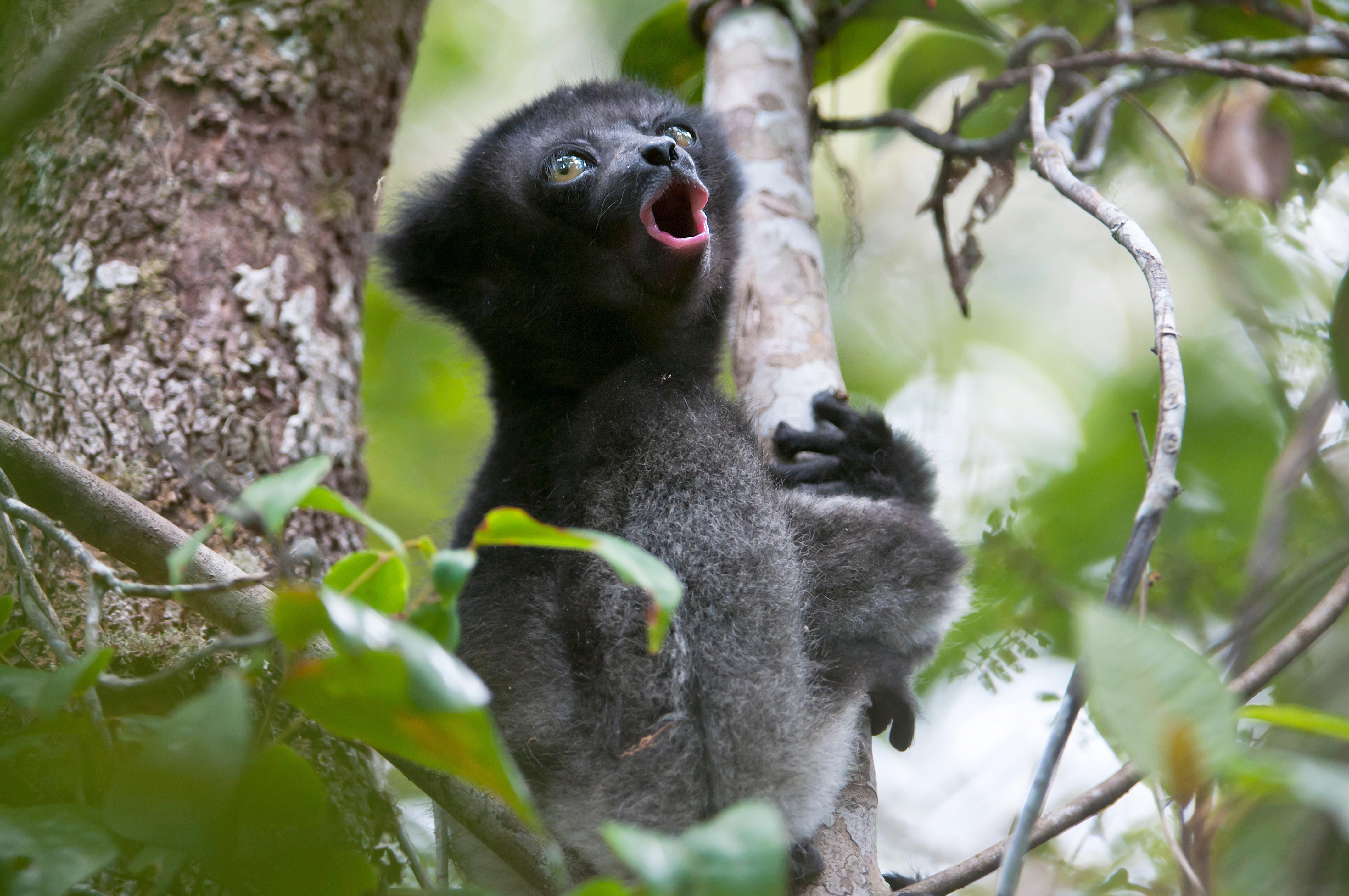
Mammals make all manner of sounds, but their calls rarely resemble music. The culprit? A lack of rhythm—the temporal sequence that organizes sounds, and the pauses between them, into a repeatable pattern. Humans have long been the only mammals known to utilize rhythm to create music. To discover how we could have acquired this ear for rhythm, scientists are exploring the musical capabilities of other mammals.
This is why a team of researchers recently trekked into the jungles of Madagascar, armed with microphones to record the remarkable calls of the indri lemur (Indri indri). Indris resemble gangly, black-and-white teddy bears with piercing green eyes. They often perch high in the rainforest canopy, where (despite being the largest species of lemur) they can be tough to spot. The animals are easy to hear, though; their bellowing cries are recognizable from over a mile away. In addition to their prodigious pipes, indris sport a varied vocal repertoire, including a high-pitched, wail-like “song” that reverberates through the rainforest.
Indris live in family groups, and their distinctive songs help different groups communicate with each other: Like a family band, the adults perform what might sound to humans like sorrowful duets, before their offspring join in for a cacophonous chorus. “When you hear an indri song, they sound hauntingly beautiful,” says Andrea Ravignani, a bio-musicologist at the Max Planck Institute for Psycholinguistics.
Indri songs may seem chaotic at first, but University of Turin biologist Chiara De Gregorio says they begin to sound less so the more one hears them. “When you get used to them you can really recognize a pattern in those songs,” she says. “When they start a phrase, you know what to expect, note after note.” In a study published Monday in Current Biology, De Gregorio, Ravignani and their colleagues analyzed recordings of 636 individual indri songs collected from 20 different familial groups to determine whether these booming lemurs do, in fact, possess rhythm.
Because rhythm is all about timing, the team dissected each recording into its base elements to measure the duration of notes and the pauses between them. The researchers compared the lengths of the intervals between each sound and found that the songs often broke down into rhythmic ratios of 1:1 (when the intervals between sounds have the same duration, like singing along with a metronome) or 1:2 (when the first interval is half as long as the second). Both are common in human music.
The researchers say their study shows indris use these patterns to structure their songs, making this the first confirmed case of a nonhuman mammal possessing categorical rhythm. Their findings applied to all the indris they recorded; females and males sing at different tempos, but both employ the same rhythmic patterns. Indris also showed the ability to maintain a constant rhythm as they decreased the tempo of their songs, a process known as ritardando in classical music.
Although indris and human composers may utilize some similar structures, each likely developed musical abilities on their own. It has been 77.5 million years since the common ancestor of humans and indris existed, a chasm of evolutionary time that makes it unlikely rhythm was an ancestral trait. Ravignani instead believes similar social pressures molded both indris and humans into singers at different times—an example of convergent evolution. The exact benefits this ability confers to indris are still unknown, but the authors speculate that organizing songs into repeatable patterns may make them easier for young lemurs to learn or help indri families quickly get on the same page when they need to defend territory or gather together.

Elizabeth St. Clair, a biological anthropologist at Johns Hopkins University who studies the evolution of the primate vocal tract, says she was surprised by the rhythmic similarities between indri and human songs. “It seems like it’s an individual characteristic of indris that are not seen in many other mammals or even birds,” says St. Clair, who was not involved in the new study. She suspects that gibbons, small apes that are native to Southeast Asia and are also known to coordinate their calls, may also utilize rhythm to structure their songs.
Dissecting indri songs indicates these animals share an underlying sense of rhythm with humans, but it raises more questions about how indris communicate. “After our recent discovery, I think these giant lemurs hide [even] more shared traits with humans than previously thought,” De Gregorio says. She wonders how an indri’s singing develops as the primate matures, and what specific purposes communicating through repetitive sounds can serve.
Unfortunately, time to answer questions like these may be running out, as deforestation and hunting have pushed indris (as well as gibbons) to the brink of extinction. Indris are particularly vulnerable; some experts estimate that as few as 1,000 remain in the wild, and all signs point to that number decreasing as Madagascar’s forests are predicted to decline by as much as 93 percent by 2070.
The researchers hope conservation efforts will help indris survive well into the future. As scientists attempt to untangle why primates began using music, hearing the songs of wild indris will be crucial. “Looking at their communication system, it’s an indirect window into their minds,” Ravignani says. “They have a lot of secrets hidden in their heads, and by looking at their sound production, we can uncover them.”
"first" - Google News
October 25, 2021 at 10:24PM
https://ift.tt/2ZjBClg
Giant Lemurs Are the First Mammals (Besides Us) Found To Use Rhythm - Scientific American
"first" - Google News
https://ift.tt/2QqCv4E
https://ift.tt/3bWWEYd
Bagikan Berita Ini














0 Response to "Giant Lemurs Are the First Mammals (Besides Us) Found To Use Rhythm - Scientific American"
Post a Comment